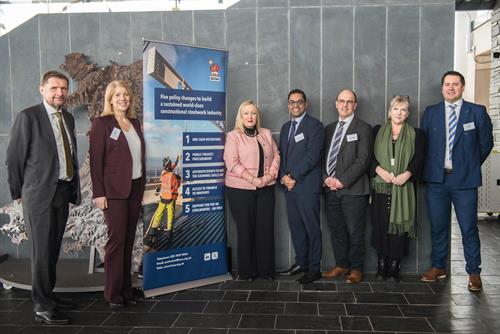
BCSA News and Insights
President's Column February 2025
03/02/2025
Category: President's Column
Fire design of car parks
In October 2023, a steel-framed car park at Luton Airport Terminal 2 was devastated by a fire started by a fault in a diesel-powered vehicle on level three. Thankfully, there was no loss of life or serious injury, although several firefighters and a member of the airport staff were taken to hospital due to smoke inhalation. However, the fire did destroy over one thousand vehicles and caused the collapse of some sections of the upper-level car park floor.
Understandably, there was an immediate call for a review of the current design guidance relating to open-sided car parks, particularly given that modern vehicles are heavier and far more combustible than they once were.
In England, the minimum recommended period of fire resistance for low-rise open-sided car parks is listed in Approved Document B (AD-B) as 15-minutes, increasing to 30-minutes for structural elements protecting the means of escape (there are equivalent documents for the other UK regions). Given the sequence of events at Luton, it would not seem unreasonable to question this 15-minute period. However, if we do so, I believe that we are misinterpreting the intent of the current guidance and are in danger of mandating an unnecessary increase in the fire resistance period that would increase both cost and carbon emissions.
The design of open-sided car parks subject to fire should consider three separate scenarios.
First, and of paramount importance, is to ensure that there is sufficient time to fully evacuate the building by means of adequately protected escape routes. I believe that all current designs include this basic requirement and, importantly, the current guidance allows for an adequate period of time to satisfy this condition.
Second, to consider the spread of the fire in relation to speed and ferocity. It is important to understand that the spread of fire in a car park occurs between adjacent vehicles and not through the structure. To control this, the design can include fire suppression solutions such as sprinklers or fire blankets, or can apply much more simplistic measures such as an increase in parking bay widths to slow down or prevent the fire spread and also reduce the potential loss of valuable assets. An increase in the period of fire resistance to the structural framing will have no effect on the spread or intensity of the fire.
Third, and a major consideration, is the protection of the fire & rescue services when tackling the blaze. It is a fundamental requirement of the design to ensure structural stability for a reasonable period of time to allow safe access for the fire-fighting teams. This requirement has no connection to the 15-minute guidance and, as noted in AD-B, a project-specific fire engineered approach can be applied to meet this requirement.
The structural collapse of steel frames subject to fire is a rarity since they are generally designed to resist far higher temperatures than actually occur in real fire conditions. The steel car park at Luton had no applied fire protection but remained stable for several hours before the partial floor collapse occurred, and any structural failure could possibly have been prevented had the fire service had more confidence in the stability of the structure to gain access to suppress the fire.
I believe it’s time for new and updated guidance to
help explain the fire engineering options available to
meet these requirements, and the technical article What
is fire resistance published in this edition of the NSC
will help to explain why different approaches are worth
considering.
Gary Simmons, BCSA President

Previous article
27/01/2025

DNV Component Certification
TCB Ltd have achieved DNV Component Certification
Next article
05/02/2025

Welsh constructional steelwork industry celebrates proud heritage and promising future at Senedd with First Minister’s backing
The vital role of Wales’ steel sector, both past and future, was recently celebrated at the Senedd, as industry leaders, apprentices, and policymakers gathered for Welsh Steel: Proud History, Bright Future.


